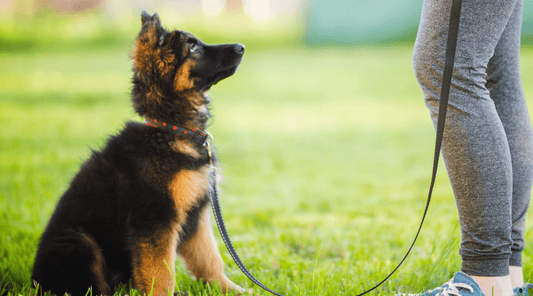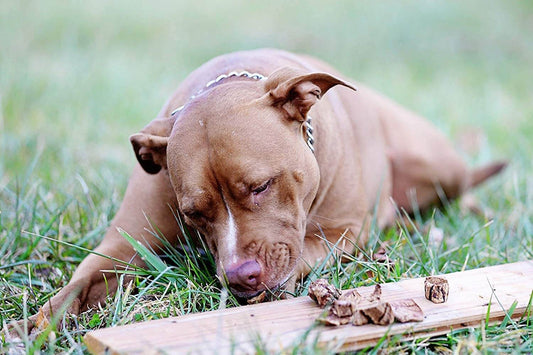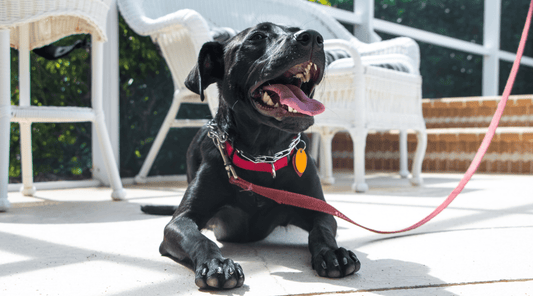
How Big Will My Puppy Get? The Mystery of Murphy
Dawn Miller Mar 07, 20254 Minute ReadHow big will my puppy get? Every new dog parent wants to know. And I've got the answer you're looking for. In my neighborhood, we recently investigated this mystery and unraveled conundrums like when do puppies stop growing.
It started with a question: How big will Murphy get?
Murphy, the fluffy golden retriever mix from three houses down, had everyone in my neighborhood buzzing. When the littlest dog parent, 3-year-old Ellie, first carried him home in her arms, he was a tiny furball that fit inside a shoebox. But just three months later, Murphy was nearly her size, wiggling under the fence, zooming across yards like a miniature racehorse, his paws far too big for his body.
“I swear, he’s growing overnight!” Ellie’s dad said one morning, scratching his head as Murphy tripped over his own legs. It reminded me of that scene in Disney's Dumbo where the little elephant falls over his ears. But fortunately, Murphy's ears aren't growing faster than the rest of him.
So, when do puppies stop growing? And just how big would Murphy get? The answer, as it turns out, isn’t as simple as weighing a pup and guessing.
How Fast Do Puppies Grow?
Small breeds like Chihuahuas reach their adult size around 8-10 months. But giant breeds like Great Danes can continue growing until 18-24 months. Medium breeds like my terrier Pixie usually fall somewhere in between.
When Do Puppies Stop Growing?
Puppies typically grow up and then out—if that makes sense. So once they start filling out with muscle and looking more like an adult of their breed, they've probably reached near their top height.
You will have some early clues that tell you when they're approaching their final size. Like a lanky teen human hitting a growth spurt, most dogs reach their full height before filling out their adult weight.
The Science Behind Puppy Growth
Puppy growth comes down to 3 key factors: breed, genetics, and nutrition. We could tell by looking at Murphy that he was a Golden Retriever mix. But because we didn't know who the daddy was, we only had part of that breed clue to work with.
While we all wish there were a magic formula to predict adult size, there isn't. But I assure you that understanding these elements can help you make an educated guess.
Breed
By far, the breed is the best clue you'll have. Breeds tend to be around the same size as they age, and they grow to full size at the same rate.
So, answering: when is a dog full grown?—it varies by breed.
If you have a mixed breed, things get trickier, though. In Murphy’s case, his golden retriever genes suggested he’d be medium to large. But the unknown side of his family tree kept everyone guessing.
We did have a bit of evidence pointing us in the right direction. You see, in the domesticated dog world, dog breed sizes vary a lot.
Technically, a pint-size Maltese and a much larger Australian Shepherd could hook up. And you could end up with a full-grown dog that's somewhere in between. But if that smaller dog is the female, you must watch the pregnancy closely as the puppies may be too large to birth.
I had a childhood friend with a female chihuahua named Abby, who had a one-night stand with Roger, a much larger poodle. She needed a C-section because, sadly, she was not physically capable of carrying the babies to term.
So, as adorable as a Shih Tsu German Shepherd puppies would be, you're not likely to see that mix. Based on this, we could infer that Murphy's dad is most likely close to the dog mama's size.
Genetics
If both parents are known, you can assume the puppy will land somewhere within their weight range. But even within the breed range, some dogs are just a little bigger or smaller because of genetics. For example, female dogs are often smaller than males. So, Murphy will likely be a little bigger than his mom.
I will mention runts here because many assume that the runt of the litter is tiny because of genetics and will be a miniature adult. But that's not usually the case. Most runts, if they survive, will reach the typical size of their littermates.
Runts happen because of a lack of nutrition in the womb. Once born, if they receive proper nutrition, they can recover from these early setbacks.
Nutrition
Proper canine nutrition plays a massive role in how fast puppies grow. A diet rich in high-quality protein, healthy fats, and essential nutrients supports steady and controlled growth.
Overfeeding or feeding low-quality foods with lots of fillers and additives can lead to rapid growth spurts. So, it may seem you're giving your puppy the A+ diet they need.
But this low-quality diet can cause joint and bone issues—especially in large breeds.
This is especially concerning for Goldens like Murphy. They often have bone and joint issues as they age.
Dog nutrition can also significantly impact the immune system, heart health, brain health, mental health, skin, coat, musculature, and dog health in general. So, not only does it influence how big they get. It can alter the trajectory of their lives—allowing them to live a longer, healthier, and happier life with you.
Supporting Healthy Growth with Nutrition
First, it's critical to choose a high-quality kibble designed specifically for puppies. Puppy kibble contains more protein, fat, calcium, and phosphorus than adult dog food. These are critical for proper growth and can impact long-term health.
But kibble has some drawbacks.
Because it's cooked at outrageously high temperatures to become shelf stable, some of the nutrition doesn't survive. Omega 3s, essential for brain, skin, and immune health, are all but non-existent in most dog food. Vitamin C, many B vitamins, and collagen protein also can't take the heat.
When speaking with Ellie's dad, I recommended that little Ellie supplement Murphy's nutrition with high-value dog treats and marrow-filled dog bones.
I told them that, personally, I choose grass-fed beef dog bones because they are 2.5X higher in omega 3 than grain-fed animals and lower in saturated fat.
Instead of overly processed snacks filled with fillers, added sugar, and artificial ingredients, I opt for natural chews like marrow bones.
These provide calcium, phosphorus, and other minerals essential for strong bones and teeth. Plus, they keep your pup occupied, which is a bonus if you have a teething terror on your hands!
But it's important to wait until around 6 months when most of the adult teeth come in to feed them dog bones. Something a little softer like single-ingredient beef trachea treats or beef lung training treats is a good choice for younger dogs.
I use beef lung bites to start training my dogs as young as possible. You wouldn't believe the skills my terrier, Pixie, has learned with regular training sessions.
I love it when I can combine high-value dog treat nutrition with training. She'll do backflips for some roasted beef lung. By the way, everyone in my neighborhood is signing up for the 7-Day Dog Training Challenge.
Discover what a growing puppy like yours can learn with positive reinforcement training and a high-value dog bone.
Available On:


Disclosure: This article may contain affiliate links, which means we may earn a small commission if you make a purchase through these links—at no extra cost to you. We only recommend products we trust and believe will benefit you and your K9.



